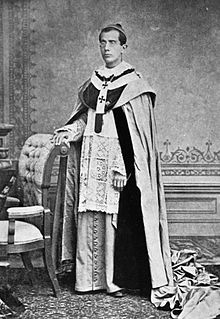Ricardo Casanova y Estrada
|
The Most Reverend and the Most Illustrious Ricardo Castanova y Estrada "The Great" |
|
|---|---|
| Santiago de Guatemala | |

Ricardo Casanova y Estrada upon his return to Guatemala in March 1897.
|
|
| Diocese | metropolitical |
| See | Cathedral of Guatemala City |
| Orders | |
| Ordination | September 21, 1875 |
| Consecration | July 25, 1886 |
| Personal details | |
| Born | November 10, 1844 |
| Died | April 14, 1913 Cantel, Quetzaltenango, |
| Motto | Crvces Salvs |
| Signature |  |
| Coat of arms | |
Ricardo Casanova y Estrada " The Great" (10 November 1844 - Cantel, Quetzaltenango, 14 April 1913) was a Guatemalan catholic priest that became the eleventh Archbishop of Guatemala from 1886 to 1913. He had a relevant role opposing president general Manuel Lisandro Barillas Bercián (1885-1896), who eventually expelled Casanova y Estrada from Guatemala. After a generous amnesty granted by president general José María Reina Barrios on 13 March 1897, the archbishop returned to Guatemala and was received by large crowds and joy.
Casanova y Estrada was well educated, receiving Literature private lessons with well known Guatemalan write and politician José Milla y Vidaurre during the 1860s; Ramón Rosa -famous Honduran liberal politician and ideologist - was his classmate in those lectures with Milla and described Casanova y Estrada as one of the most distinguished young men of both Guatemala and its neighboring republics, as well as the most educated priest in Central America. Casanova y Estrada later studied in the Pontifica Universidad de San Carlos Borromeo where he studied again with Milla y Vidaurre and also with former Columbian president doctor Mariano Espina, who was exiled in Guatemala. Among his classmates there were Marco Aurelio Soto, Ramón Rosa, and .
He was appointed archbishop of Guatemala in 1886 and had a series of confrontations with president general Manuel Lisandro Barillas Bercián, who ended up expelling him from Guatemala.
While bishop Casanova y Estrada was exiled in Costa Rica, he expressed a very high regard about the Exposición Centroamericana which general José María Reina Barrios, was organizing at the time. In a pastoral message sent from San José, on 29 June 1896 Casanova y Estrada pointed out that the Expo would allow the government to reach to great goals: that Central American get to know among themselves much better and that the area products would be showcased to the rest of the world. After almost 10 years in exile, and coinciding with the 75th Central America Independence anniversary, Casanova y Estrada. Upon learnings about this, president Reina Barrios -who happened to be a high ranked mason - realized the bishop's patriotism and presented an initiative to the National Assembly on its inaugural session of 1 March 1897 to allow his return to Guatemalan soil. On 13 March, Decree 351, allowing archbishop Casanova y Estrada to return to Guatemala, was approved.
...
Wikipedia
